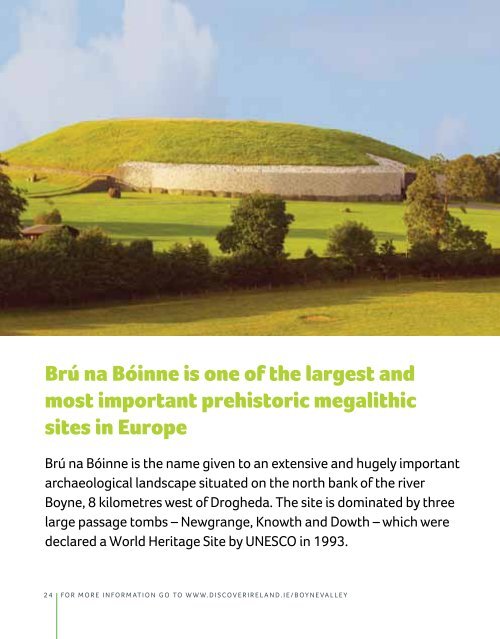Free Guide - Discover Ireland
Free Guide - Discover Ireland Free Guide - Discover Ireland
Brú na Bóinne is one of the largest and most important prehistoric megalithic sites in Europe Brú na Bóinne is the name given to an extensive and hugely important archaeological landscape situated on the north bank of the river Boyne, 8 kilometres west of Drogheda. The site is dominated by three large passage tombs – Newgrange, Knowth and Dowth – which were declared a World Heritage Site by UNESCO in 1993. 24 FOR MORE INFORMATION GO TO WWW.DISCOVERIRELAND.IE/BOYNEVALLEY
Passage tombs consist of a burial chamber reached by a long straight passage lined with stones, and set within a large mound known as a cairn. They are usually sited on hilltops and grouped in cemeteries. Although primarily burial sites, they also served as status symbols, focal points for the community, places to honour dead ancestors and as territorial markers. It is estimated that there are 700 decorated stones at Brú na Bóinne making it Europe’s largest and most important concentration of prehistoric megalithic art. The most famous of these stones is the one marking the entrance to Newgrange where the triple spiral, unique to this site, can be seen. Constructed during the New Stone Age (or Neolithic Period, from Greek “neo” meaning new and “lithos” meaning stone) the tombs at Brú na Bóinne are around 5,000 years old. Although the people who built these tombs were primarily farmers they also possessed expertise in engineering, geology, art and even astronomy. At dawn on the morning of the winter solstice, and for a number of days before and after, the main chamber at Newgrange is illuminated by a beam of sunlight for 17 minutes. This alignment is too precise to have occurred by chance. It is thought that Newgrange is the oldest surviving deliberately aligned structure in the world. Although Newgrange, Knowth and Dowth were constructed around 3000 BC activity Brú Na Bóinne (Newgrange) at the sites continued for many millennia. Knowth for example, served as a burial site in the Iron Age, as the royal seat of the King of Northern Brega in the Early Christian period, and as an Anglo-Norman Motte in the Early Medieval Period. There is no direct access to Newgrange and Knowth; all admission is through the Brú na Bóinne Visitor Centre which is located near the village of Donore. The excellent exhibitions at the Visitor Centre include a full scale replica of the chamber at Newgrange. Visitors are brought from the centre to the monuments by shuttle bus. Did you know … Constructed around 3200 BC, Newgrange is 500 years older than the pyramids of Egypt and 1,000 years older than Stonehenge in England. Contact Details: Brú na Bóinne (Newgrange & Knowth), Donore, Drogheda, Co. Meath GPS: 53° 41’ 40.20”, -6° 26’ 46.68” T: + 353 (0) 41 988 0300 F: + 353 (0) 41 982 3071 E: brunaboinne@opw.ie W: www.heritageireland.ie Notes: Visitor Centre and Newgrange is open all year round. (excl. 24-27 December). Knowth is open from Easter to end of October. Last admission to the visitor centre is 45 minutes before closing time. Last admission to visit any of the sites is 2 hours before closing time. Please note this site can be extremely busy during the summer months – early arrival for booking of the tours is recommended. See www.heritageireland.ie for additional information. FOR OPENING TIMES AND ADMISSION DETAILS PLEASE SEE PULL OUT INSERT AT THE BACK 25
- Page 1 and 2: Free Guide Discover Ireland’s ric
- Page 3 and 4: ogheda) 4 1 6 5 2 Dunleer 2 1 16 3
- Page 5 and 6: Discover Ireland’s rich heritage!
- Page 7 and 8: “So memorable in ancient history,
- Page 9 and 10: Bronze Age 2200 - 600 BC Industrial
- Page 11 and 12: more recently with canvas. It was a
- Page 13 and 14: The imposing façade of St. Peters
- Page 15 and 16: Did you know … The current owner
- Page 17 and 18: William’s army (called Williamite
- Page 19 and 20: * An Artist Impression, as it might
- Page 21 and 22: Christianity was introduced into Ir
- Page 23 and 24: West Face (top to base) Ascension o
- Page 25: Stereophonics, Red Hot Chili Pepper
- Page 29 and 30: * An Artist Impression, as it might
- Page 31 and 32: King of Connacht (and last High Kin
- Page 33 and 34: is credited with Napoleon’s defea
- Page 35 and 36: tower. The tower is surrounded by s
- Page 37 and 38: Loughcrew is roughly contemporary w
- Page 39 and 40: Solstice Arts Centre could safely h
- Page 41 and 42: Drogheda proper began as an Anglo-N
- Page 45 and 46: The Salmon of Knowledge - Illustrat
- Page 48 and 49: Getting to the Boyne Valley is very
- Page 50 and 51: Suggested Itinerary 2 M Morning L L
- Page 52 and 53: Your Road Map See detailed touring
- Page 54: Notes For further information pleas
Brú na Bóinne is one of the largest and<br />
most important prehistoric megalithic<br />
sites in Europe<br />
Brú na Bóinne is the name given to an extensive and hugely important<br />
archaeological landscape situated on the north bank of the river<br />
Boyne, 8 kilometres west of Drogheda. The site is dominated by three<br />
large passage tombs – Newgrange, Knowth and Dowth – which were<br />
declared a World Heritage Site by UNESCO in 1993.<br />
24 FOR MORE INFORMATION GO TO WWW.DISCOVERIRELAND.IE/BOYNEVALLEY



